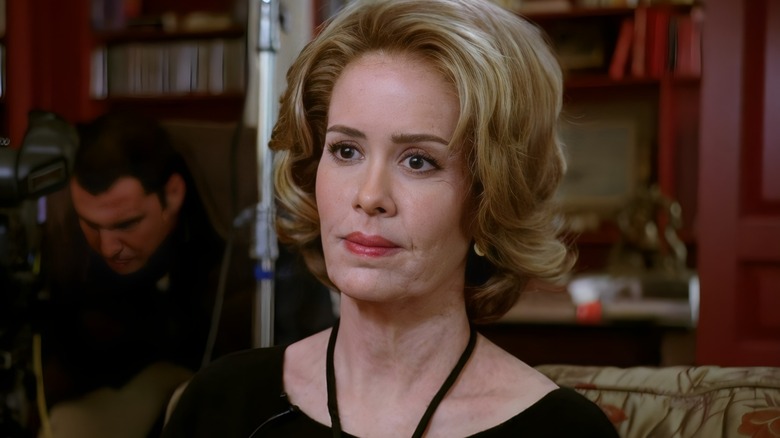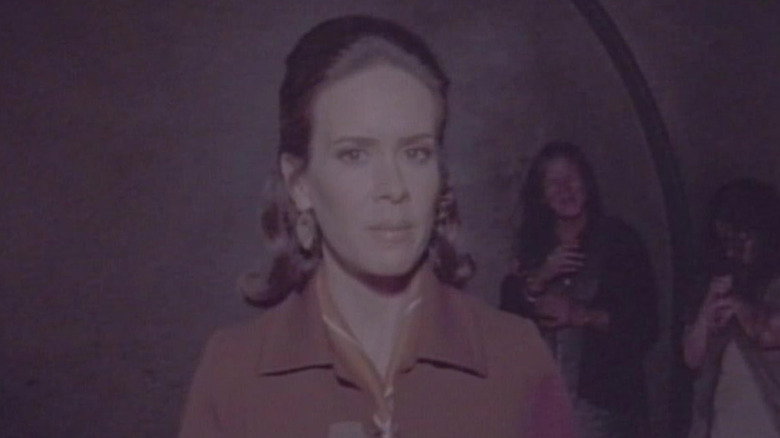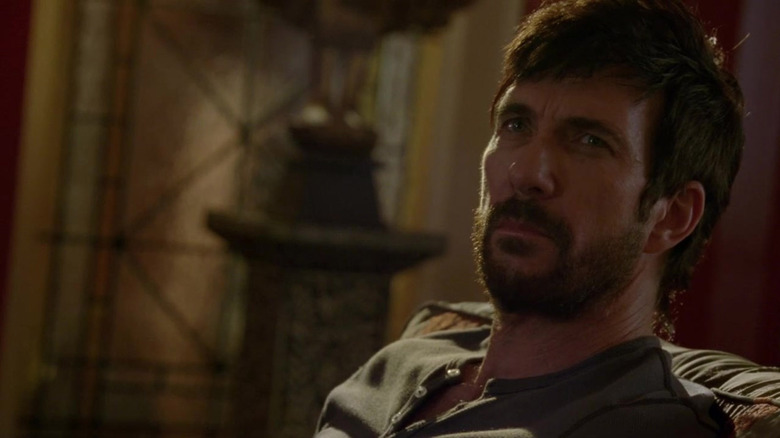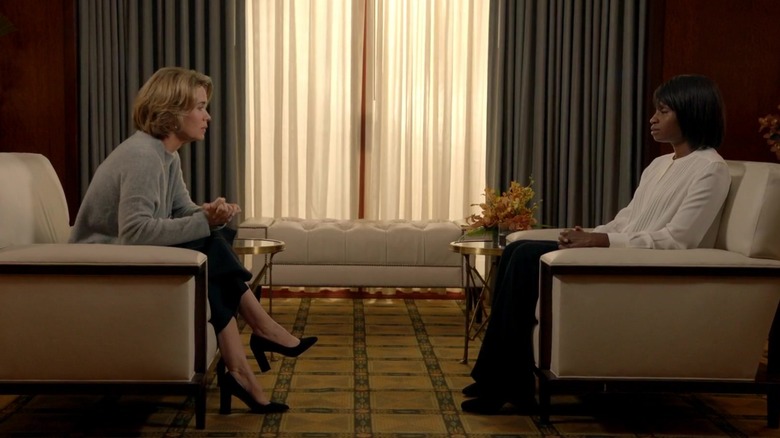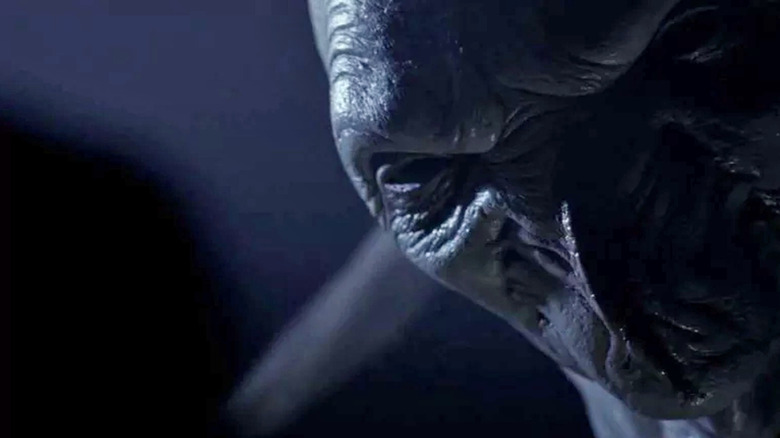The Ending Of American Horror Story Season 2 Explained
"American Horror Story: Asylum" had a lot to prove. As the first sequel season to "Murder House," "Asylum" had to demonstrate to viewers how the whole anthology series format was going to work. When "Murder House" ended with nearly every main character dead, fans were confused as to how the show would move forward. Then co-creators Ryan Murphy and Brad Falchuck explained that "AHS" would be an anthology series, with each season telling a discrete story but utilizing some of the same cast.
"The next year of the show — every season of the show — will be a different haunting," Murphy told the New York Times. "So what you saw in the finale was the end of the Harmon house, and the second season of the show will be a brand new home or building to haunt." As the first new building to haunt, "Asylum" introduced the "AHS" brand: the regular returning cast members, plus all the different horrors that could befall its characters. The end of "Asylum" was crucial for setting up future connections to other "AHS" seasons, as well as proving the show could tell a wholly different story each season. Here's how they did it.
The end of Briarcliff
The main setting of "Asylum" was Briarcliff Manor, a tuberculosis ward turned insane asylum. The Catholic church bought Briarcliff and turned it into a mental hospital in 1962. The ending of "Asylum" shows the literal end of Briarcliff as an asylum. After having escaped Briarcliff in the late '60s, journalist Lana Winters (Sarah Paulson) returns in 1971 to expose the hospital for its cruelty and out Dr. Arden (James Cromwell) as a Nazi war criminal. The filmed exposé she does of Briarcliff mirrors the real-life exposé of Willowbrook State School by Geraldo Rivera.
A major theme of "Asylum" is religious trauma. Sister Jude (Jessica Lange) punishes the mentally ill because she believes that sin has caused their minds to break. She thinks her cause is righteous, even though Briarcliff is so toxic that the literal devil is able to walk right in. As Briarcliff is exposed for being cruel, so is the Catholic church for its role in perpetuating that harm.
Everyone who worked at Briarcliff suffers for what they did to their patients. Monsignor Howard (Joseph Fiennes) kills himself after Dr. Arden is exposed. Sister Jude, having already become a patient, is rescued by Kit Walker (Evan Peters). She softens in her later years, helping to care for Kit's children before finally succumbing to the Angel of Death's kiss.
Bloody Face's return
"Asylum" runs on two timelines for a chunk of its episodes. There's the story of Briarcliff in the '60s, and then a separate story where a new Bloody Face — the alter ego of a serial killer — terrorizes some urban explorers. These two timelines finally converge in the last episode, where we find out that the new Bloody Face is the child born of Dr. Thredson's sexual assault of Lana.
Dr. Thredson (Zachary Quinto) was the first serial killer with the Bloody Face moniker, punishing women for not being maternal enough. Lana, having been terrorized and assaulted by Thredson, feels no motherly feeling for her son born of that rape. It's not her fault, but Lana's trauma perpetuates the cycle of harm that started with Thredson. Her son picks up where his dad left off, becoming the new Bloody Face, until Lana shoots him dead.
Ryan Murphy made a point of not having any ghosts in "Asylum." Except for the occasional angel or alien, the horrors of "Asylum" are man-made. Bloody Face Jr. underscores how even the show's most heroic character, Lana, can contribute to the pain and suffering of others.
Connections to other AHS seasons
All the seasons of "American Horror Story" share an overarching universe. Murphy and Falchuck acknowledged the connections for Seasons 1-8, but fans also found connections between "1984" and other AHS seasons. One such connection exists between "1984" and "Asylum." Margaret Booth (Leslie Grossman) briefly tries to flip Briarcliff Manor at her real estate business. Margaret buys up haunted and/or cursed properties across America, including real-life Spahn Ranch and Briarcliff.
Another connection to "1984" occurs when Mr. Jingles (John Carroll Lynch), resurrected by the devil, flees to a remote cabin in Alaska and starts a new life. That cabin, fans noted, looks exactly like the one Kit lived in after leaving Briarcliff.
Lana Winters returns in "Roanoke," doing a Barbara Walters-esque interview with Lee Harris (Adina Porter). She's also mentioned in a meta moment in "Cult," asking to interview Sarah Paulson's character for that season, Ally Mayfair-Richards.
"Freak Show" connects to "Asylum" through Pepper (Naomi Grossman) and Dr. Arden. The character traveled with Elsa's freak show and later is framed for her sister's murder. She's sent to Briarcliff instead of prison. In an episode of "Freak Show," it's revealed that Dr. Arden removed Elsa's legs in a German snuff film.
What was with the aliens?
Kit's aliens return in the final episode of "Asylum," leaving viewers with more questions than answers. Kit and his wife Alma (Britne Oldford) were two of many "AHS" characters based on real people, in this case, alleged abduction survivors Barney and Betty Hill. Like Kit and Alma, they were an interracial couple who claimed to have been taken by aliens while driving. But the sci-fi element seemed somewhat amiss to some fans in a season that was so focused on religion and man-made cruelties.
Ryan Murphy, on the other hand, sees no difference between angels and aliens. "For me, [aliens] were always an obvious metaphor for God," Murphy told Entertainment Weekly. "It fit very easily into the world of a Catholic sanitarium asylum." He added, "It was also about science versus faith so it made sense to me."
In the final episode, the aliens return for Kit, who is dying of pancreatic cancer. As the aliens are a metaphor for God, it seems like his abduction is a happy ending: getting taken to heaven before feeling the pain of death. Lord knows Kit had enough pain on Earth.
